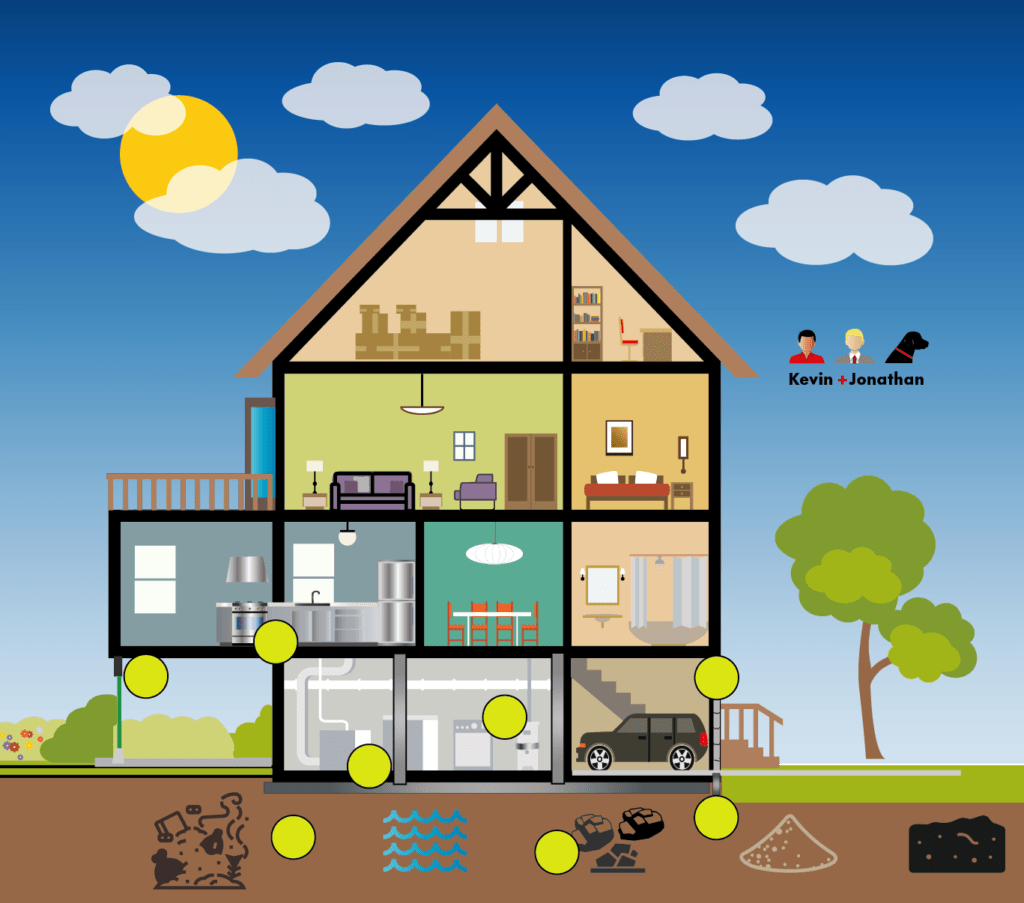Kevin+Jonathan
Seismically Speaking
The area is prone to ‘seismic events‘ normally known as earthquakes. Kevin+Jonathan go over some of the details and considerations when it comes to houses and quakes.
ON HOMES AND EARTHQUAKES
Shake.
Rattle.
Roll.
(Okay, hopefully not)
Buying property in the Bay Area is not only an expensive endeavor but one that inherently implicates earthquake concerns as scary as it may seem — think about the ground literally shaking underneath you or, in some cases, liquifying beneath you.
Safety and protecting life is obvious, but protecting your investment is another worry. Good thing that building technology has come a long way since the 1906 quake. When considering a property anywhere in the region, you have to keep in mind that this is one of those areas where each property is truly unique. researching the U.S. Geological Service and reading (required) natural hazards maps and earthquake hazards safety statement in disclosure packages are the first places to start along with asking us and, if needed, consulting a structural engineer for deeper questions about a given property.
Seismically Speaking: We Usually Know What You Need to Know
We speak with our trusted structural engineers, expert contractors and architects about how homes have been built here, how they should be built here and what is required here in the Bay Area. Also, having done our own home’s major renovation which involved a lot of foundation, structural strengthening and load-bearing alterations, we have just a little experience enough to know when you need to talk with any one of these experts in their fields.
What You Should Ask
Before delving into the details here are some key questions/points to keep in mind when thinking quakes and houses:
Age?
The more modern something is the better it should be (in theory), right? But remember there are plenty of pre-earthquake homes still standing after all these years (and quakes) or that have otherwise been rebuilt with steel, concrete and moment frames. So look closer.
Location?
This matters as there are liquefaction zones, being downhill from a reservoir, tsunami zones, being on, near or under a hillside, being a corner lot or in the middle of a block (which is better). Look at the Natural Hazards Report which will show ’shake zones,’ ‘liquefaction zones,’ ’landslide risk,” among more things.
Does the City Care?
The powers that be in San Francisco, through the Planning Department and the Department of Building and Inspection (DBI) have created and implemented various seismic updating requirements over the years. From the ‘brick list‘ to the soft-story retrofit mandated programs, the City has required various upgrades to multi-unit buildings like steel and concrete moment frames for example. (See below or here).
Current Foundation? Is There a Grade Change? A Hill?
Brick or concrete, or, in some cases, none?! Replacing a brick foundation may not be required in some cases. It also matters on the soils in which a foundation sits — bedrock or fill? (See above and be sure to review inspection reports and online resources like this from the City).
What’s been done?
What type of upgrades have been done, what’s possible? (shear walls, strapping, bolting, steel, etc.) Most seller agents will highlight major upgrades if there are any while most sellers and their agents will answer question on the Earthquake Hazards Report will be ”don't know“ if there are few or no upgrades.

Knowledge is a Mouse Scroll Away
EQ-related Disclosure Documents
The two relevant disclosure documents that discuss seismic issues is the seller-completed residential earthquake hazards report and the standardized JCP report that uses USGS seismic maps to illustrate the soundness of the ground upon which the property sits. True, most seller-completed reports simply see the sellers check the “don’t know” box, but sellers will usually play up any updates they’ve done, were forced to do as part of an upgrade or know about. Another very good resource that come with most disclosure packages in San Francisco now is a pre-sale property inspection report from a general contractor — be sure to look at that resource.
- Visit: https://earthquake.usgs.gov/hazards/urban/sfbay/liquefaction/sfbay/
- Also, https://www.conservation.ca.gov/cgs/shp
We’ll give you our perspective as we’ve been through our own seismic upgrade at our own house, have seen lots of houses and buildings and have talked with and ‘rode along’ consults from structural engineers and will be able to give you a general sense of what to look for and how to frame your questions and assessment (pun very much intended), but we’re not structural engineers. If this is a big concern for you or the property unique enough, it is also advisable to consult a licensed professional structural engineer to chime in; we have referrals for that if need be.

City Government at Work
What Has the City Done About Seismic Safety?
San Francisco authorities have implemented various mandated retrofit requirements to its various buildings over the years. There’s the ubiquitous water heater strapping requirement — all gas water heaters (the ones with tanks) need to be strapped to a wall so they don’t tip over and break gas line connections during an earthquake which leads to fires. Apart from that, starting with buildings with brick foundations and those at corners during the 1980s, 1990s and 2000s, the city set a schedule for unreinforced masonry buildings (UMBs) to retrofit their foundations because bricks and mortar shake deteriorate over time and can fail when the shaking starts.
- Learn more about the brick list (the UMB List) here.
Then seeing the devastation wrought by the 1995 Kobe earthquake, the city moved to upgrade ‘soft story’ buildings — buildings with residential units built over garages — on a similar multi-year schedule starting with buildings with a large number of units (10+) that has worked its way down to 5-unit buildings.
- Learn more about the current soft story list visit here

That Sinking Feeling...?
Liqui...what?
Location. Location. Location. In this case, location matters more. San Francisco developed over time was developed over time east to west with lots of areas being filled in — inlets drained (Mission Bay), streams being buried or forced to go underground (Mission Dolores) or bays being filled up with trash (the Marina) and sands being pushed away (the Sunset) and stilts being put up (Midtown Terrace).
While many neighborhoods are on bedrock (Bernal, Twin Peaks, Noe, Russian Hill, Telegraph Hill, Pacific Heights, etc), others are now. The main concern you hear about (with many buyers ruling out these areas out of hand) is if a property sits atop a liquefaction zone which means that either the soil itself will act like a liquid if the ground started shaking or that water will literally slosh around with the fill so that it causes the ground to, well, liquify. Both instances are bad for rigid foundations especially if there’s a brick foundation involved.
The main areas you hear about the most in San Francisco associated with liquefaction (see the map) are the Marina (fill from the world’s fair thrown into the bay and built on); SOMA (a swampy, muddy shoreline that was drained and filled in) and Mission Bay (same as SOMA). Given the housing stock and cost of houses in the Marina, seismic upgrades and updates are on a case-by-case basis as most buildings are smaller and older. For SOMA, because a lot of the area’s warehouses have been replaced with modern loft and condo buildings that were built subject to updated building codes with provisions mandating seismically sound construction. And for Mission Bay, where nothing existed before, all those new buildings were built with a thud, thud, clank soundtrack of giant metal pylons being driven down through the ground until they hit bedrock many, many feet below the surface.
See much more at: https://earthquake.usgs.gov/hazards/urban/sfbay/liquefaction/sfbay/
What About Underground Streams?
So there are a few pockets of liquefaction zones you may come across in the City — one in Diamond Heights near where the underground stream used to flow (above ground or otherwise) in Glen Canyon, another in the Lower Height/Duboce Area (near the park along Steiner and Page Streets), and the one in the Mission District that saw flooding during 2022's atmospheric river In fact, one local made a whole map of them that you can order.
- See the project map here: http://seepcity.org/
How About EQ Insurance?
Less than 15 percent of homeowners have specific earthquake insurance which California requires insurers to offer. Because deductibles are high (at least $500/month for a median priced San Francisco home of $2M), and coverage low for personal property (capped at $200,000), most folks simply don’t get it. But you should definitely decide for yourself.
Learn more at: https://www.earthquakeauthority.com/California-Earthquake-Insurance-Policies/Homeowners
And About Those Retrofits…
Seismic structural elements have been evolving just as engineering knowledge and building material technology has developed. The leap from lath and plaster to drywall for example shows that things do change. Concrete, for example, is a much more relevant example here. Earlier concrete foundations were made with ocean water or ocean sand (both with sodium chloride molecules that break down the material over time) without any steel rebar. Now, we have steel rebar and smart concrete mixes that can withstand thousands of pounds per square inch that will have samples sent off for lab testing to make sure it’s as robust as can be. The advent of various straps, hold-downs, tie-downs and much more from the Simpson Strongtie Company (they thank you for your support we’re sure) has also combined with new engineered materials like glue-laminated beams that can be used instead of steel. Lots of possibilities. Anyway here are some things that should be on your radar to see if they’ve been done or things to add to your to-do list if you’re planning on renovating at one point.

- A Moment Frame (or two) and/or Grade Beams. These are above- and underground concrete and steel rebar that ring around and connect the two side walls of the existing foundation. Shear walls from the interior of the house usually key-in to these frames which are meant to augment the structure’s main beam which runs parallel to the side walls.
- Most older homes will have an old-growth, redwood main beam. This wood had hundreds of years to grow before it was chopped down and put into homes. This wood type is denser and sturdier than younger lumber stock and is still ‘good’ according to those who know. A moment frame (or moment frames) provides important lateral rigidity to support a building's structural integrity against side-to-side shaking during an earthquake. These beams are placed at a 90-degree angle to the building's main beam and spam the width of a garage. The beam(s) are held up by new posts that are sunk into new concrete-base that is trenched across the garage underground, all of which is connected and embedded into the side walls of the garage. Depending on the length, width, and design of the building as well as how much weight (load) is being supported you may need just one moment frame up to 10 or more. The grade beam is the same concept as a moment frame but is on the exterior wall in the front usually running under the garage door.
- Metal Straps for Wood Support Beams and Joist Hangers. If you don't have to replace wooden posts in garages or foundations completely your engineer may recommend that the connection to the ground (not the slab) sit in its own concrete pedestal. Contrary to looks, the concrete slab doesn't have as much to do with soundness than the perimeter walls and moment frames. As mentioned above, most products come from the Simpson Company (not Homer and Marge but almost as ubiquitous in this realm)
- Mudsill-Concrete Anchor Bolts. This system works by having a contractor drill a hole through the very last bit of horizontal wood framing element (usually the mudsill) into the concrete exterior foundation wall. The hole gets filled with epoxy and a bolt and washer is drilled through the wood into the hole with epoxy with it all being screwed down with an air hammer. These bolts are added every 18 inches (thereabouts) all around the foundation’s perimeter. After it's all said and done inspectors may go around and randomly try to unscrew those bolts with high-psi air hammers with the minimum threshold being 25,000 psi. Many times you’ll see some bolting but not nearly as frequent as 18 inches. That’s probably better than nothing but you can always do more. Speaking of doing more, bolting is usually followed on by…
- A Finished Plywood/Sheetrock Garage/Foundation Area. After the bolting is done then exposed wood framing is covered up with plywood and/or sheetrock that adds just another layer of rigidity. There is a very specific pattern and number of screws (not nails) that need to be followed in order for the upgrade to be effective.
- Steel Rebar Concrete Foundations. New construction or replacement sections of old foundations should have steel rebar framework inside newer and better concrete formulations. You’ll see more connections where rebar cages meet walls and other parts of the foundation system. (Well, actually, unless you’re doing the work yourself this stuff should be covered up).
- Rebuilt Foundations (either partial or complete). Like filling in a decayed cavity, progressive maintenance will see parts of foundations replaced over time whereby the mudsill-connection to the foundation is raised up higher (so as to combat termites and rot) and new concrete poured in so that the mudsill sits above grade.
- French Drain Systems with Sump Pumps. While a home's surrounding grade is supposed to be sloped away from its foundation if runoff water can't flow away fast enough, some properties need a buried PVC drain/catch system that's ultimately aided by a sump pump, which will pump water into the City's wastewater system if not elsewhere. The thinking here is to ensure that the soils around a home are also clear and able to do some work too.
- Steel or Glu-lam header beams over garages and main beams. Over garage doors especially with reinforced posts and framing around as garages are the weakest structural parts of a foundation. Header beams usually work in concert with other posts, metal fasteners and grade beams.
- Wood posts with their own rebar-and-concrete footings that are strapped and/or bolted to that footing. If posts are being completely replaced, they’ll get their own designed post connector that is made of steel. Other times, you may get a T-shaped metal strap, or an L-shaped connector with bolts or all kinds of other metal fasteners.
- Engineered and Laminated wood. While younger wood, by itself, is not as dense and 'solid' as their old redwood growth counterparts. But if that wood is engineered then we have something else to consider. This happens when multiple layers of wood are heated, layered on top of each other, glued and compressed. That or when the strands (grains) are oriented in concert with each other. This type of material is denser and may be preferred to steel beams in a fire as steel can get all molten and droopy.
What Else?
Read more about related topics below
